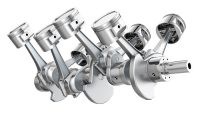Vehicles are propelled by the intricate dance of processes within the internal combustion engine (ICE). This engine masterfully orchestrates fuel ignition and combustion directly within its structure, converting the energy released into heat and, crucially, mechanical torque. This conversion is the heart of automotive motion, powered by a symphony of interconnected components working in perfect harmony.
1. Engine Block & Cylinders: The Core Structure
 engine pistons and crankshaft
engine pistons and crankshaft
Think of the engine block as the robust skeleton of your car’s engine. Typically crafted from durable aluminum or iron, this foundational component is the housing for the engine’s most vital parts. It securely cradles the pistons, crankshaft, and connecting rods, organizing them into a cohesive unit. The engine block is structurally divided into three key sections: the cylinder head, the main block itself, and the crankcase.
Within the engine block are precisely bored holes that form the cylinders. These are metal tubes, numbering from 4 to 16 depending on the vehicle’s design and power requirements. The diameter of these cylinders is a critical factor, directly determining the engine’s displacement – the total volume swept by all pistons. It’s within these cylinders that the magic of fuel combustion occurs, driving the pistons in their reciprocating motion. Beyond housing the cylinders, the engine block also incorporates essential pathways for coolant and oil. These internal channels are indispensable for maintaining optimal engine temperature and ensuring continuous lubrication, preventing overheating and wear.
2. Pistons & Crankshaft: Converting Combustion into Motion
The journey of rotational force that ultimately turns your car’s wheels begins with the piston. Pistons are the critical intermediaries in this process, tasked with capturing the explosive energy generated during the combustion cycle. Their primary function is to transfer this energy, converting it into a mechanical force that is then passed on to the crankshaft, the engine component responsible for propelling the vehicle.
Pistons achieve this energy transfer through a linear, up-and-down motion within the cylinders. The intense heat and rapidly expanding gases from combustion exert pressure on the piston head, forcing it downwards. This linear motion of the pistons is then ingeniously converted into rotational motion by the crankshaft. Connected to the pistons via connecting rods, the crankshaft is located in the lower section of the engine block. Its sophisticated design is specifically engineered to transform the piston’s vertical movement into a rotational and reciprocal motion, spinning at engine speed.
The crankshaft is a component demanding exceptional precision in its manufacture. It requires meticulous balancing to operate smoothly and efficiently, especially at high engine speeds. Strategically placed holes are incorporated into its design to ensure balanced rotation, preventing vibrations and ensuring longevity.
3. Camshaft: Regulating the Engine’s Breath
The camshaft, while perhaps less visibly prominent, plays a pivotal role in the engine’s operation. Its primary function is to act as the timing regulator for the engine’s valves. It precisely controls when the intake and exhaust valves open and close, orchestrating the engine’s breathing process. The camshaft achieves this by pressing on the end of the valve stems at specific intervals. Without the camshaft’s precise timing, the engine’s combustion process would be disrupted, making engine start-up and efficient operation impossible.
Conversely, the camshaft also performs the function of motion conversion. It receives the rotary motion from the crankshaft and cleverly transforms it back into linear motion. This converted linear motion is what it uses to actuate the valves, ensuring they open and close at the precise moments needed for the engine to breathe and function correctly.
4. The Importance of Engine Cooling for Optimal Function
While each of the main car engine parts described contributes to your vehicle’s engine performance, maintaining optimal operating temperature is equally crucial. The engine cooling system is a vital support system for these components.
During engine operation, intense heat is generated from fuel combustion and the constant friction of moving parts. Without an effective cooling system to dissipate heat away from the engine, temperatures would rapidly escalate, leading to engine overheating. Overheating can cause significant damage, ranging from reduced performance and component wear to catastrophic engine failure in severe cases.
Deep within the engine, often concealed by the timing belt, lies the water pump. This component is the heart of the cooling system, actively circulating coolant throughout the engine block. This coolant absorbs excess heat and carries it away to the radiator, where it is dissipated into the outside air. This continuous circulation of coolant is essential for maintaining a stable engine temperature, preventing overheating, and ensuring the longevity and reliable function of all engine parts.